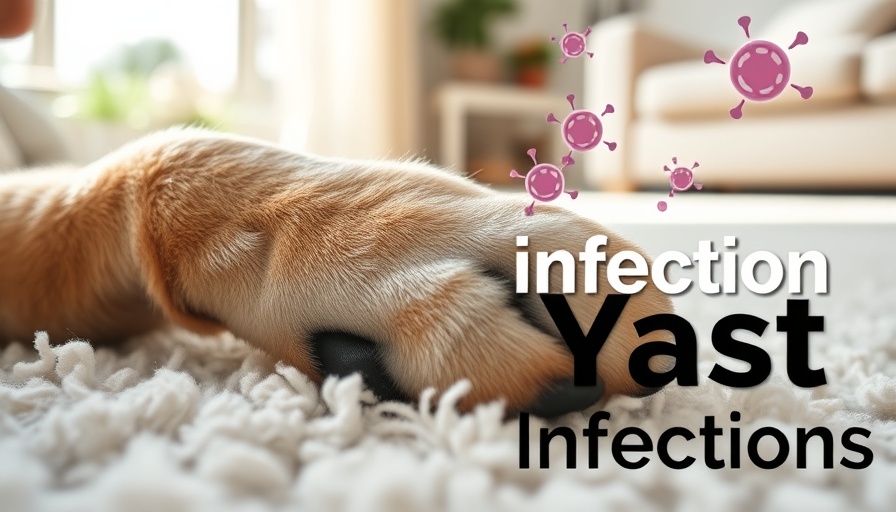
Understanding Yeast Infections in Dogs: A Common Concern
Dogs, much like humans, can be afflicted by a variety of health issues, one of which is a yeast infection on their paws. Yeast infections, particularly caused by the fungus Malassezia pachydermatis, may arise from an imbalance in the skin's natural flora, leading to excessive growth and discomfort for our furry friends.
Common Symptoms to Look Out For
The telltale signs of yeast infections are often unmistakable. If your dog is obsessively licking, chewing their paws, or emitting a musty odor, it's time for a closer inspection. The initial signs include:
- Redness and Irritation: Infected areas may appear inflamed and red.
- Persistent Licking: Watch for excessive grooming behavior, particularly on the paws and between the toes.
- Discharge: Brown or yellowish discharge can also be a symptom of infection.
- Hair Loss: Noticeable thinning of fur in the affected areas might be observed.
Identifying the Triggers of Yeast Overgrowth
Understanding what prompts yeast overgrowth in dogs is crucial in preventing future episodes. Various factors can contribute:
Environmental Factors
Moist environments, such as post-bath or after walks during rainy seasons, create ideal conditions for yeast proliferation. Dogs that frequently traverse grassy or damp areas may also encounter fungi that lead to an infection.
Food Sensitivities
Some dogs might have food allergies or intolerances, primarily to grains and certain proteins, which can contribute to yeast overgrowth. Switching to a hypoallergenic diet while including probiotic-rich foods may help manage this condition.
Compromised Immune System
Dogs with health issues, like Cushing's disease or those taking immunosuppressive medications, are more susceptible to infections as their bodies struggle to maintain balance.
Why Professional Assessment Matters
If you suspect a yeast infection, veterinary consultation is important for a proper diagnosis. Self-diagnosis can lead to mismanagement and worsening of the condition, particularly because the symptoms can resemble other skin irritations.
Treatment Options for Yeast Infections
Effective treatment involves a combination of topical and dietary interventions:
Topical Treatments
Veterinarians often recommend regular foot soaks using povidone-iodine or antifungal solutions to eliminate yeast from the paws. Therapeutic washes can also provide relief from discomfort and irritation.
Dietary Adjustments
An anti-inflammatory diet low in starch can significantly aid in controlling yeast growth. Incorporating antifungal foods like pumpkin, coconut oil, and fish can provide essential benefits, and considering the addition of probiotics can help restore gut health.
Preventive Measures to Keep Your Pet Healthy
Prevention is always better than cure. Here are some practical steps every pet owner can take:
- Maintain Cleanliness: Ensure your dog’s paws are clean and dry, especially after walks.
- Diet Management: A balanced diet tailored to your dog’s needs can prevent nutritional imbalances. Regularly consult with your veterinarian to ensure they are on the right food.
- Regular Vet Check-Ups: Routine visits will help in early detection of any underlying conditions that could lead to yeast infections.
When to Seek Help
While some dog owners might consider a yeast infection a minor inconvenience, neglecting treatment can lead to more severe discomfort for their pets. If you notice persistent symptoms despite home treatments, visiting your vet can help provide the necessary medical intervention. Your dog's health is paramount, and ensuring they live a comfortable, healthy life starts with being attentive to their needs.
Final Thoughts on Pet Wellness
As loving pet owners, we hold the responsibility of keeping our dogs healthy and happy. Awareness of yeast infections and their symptoms is critical in safeguarding your pet's wellbeing. By understanding the causes, noting the signs, and implementing preventive measures, you can greatly contribute to your dog’s overall health.
 Add Row
Add Row  Add
Add 




 Add Row
Add Row 


 Add
Add
Write A Comment